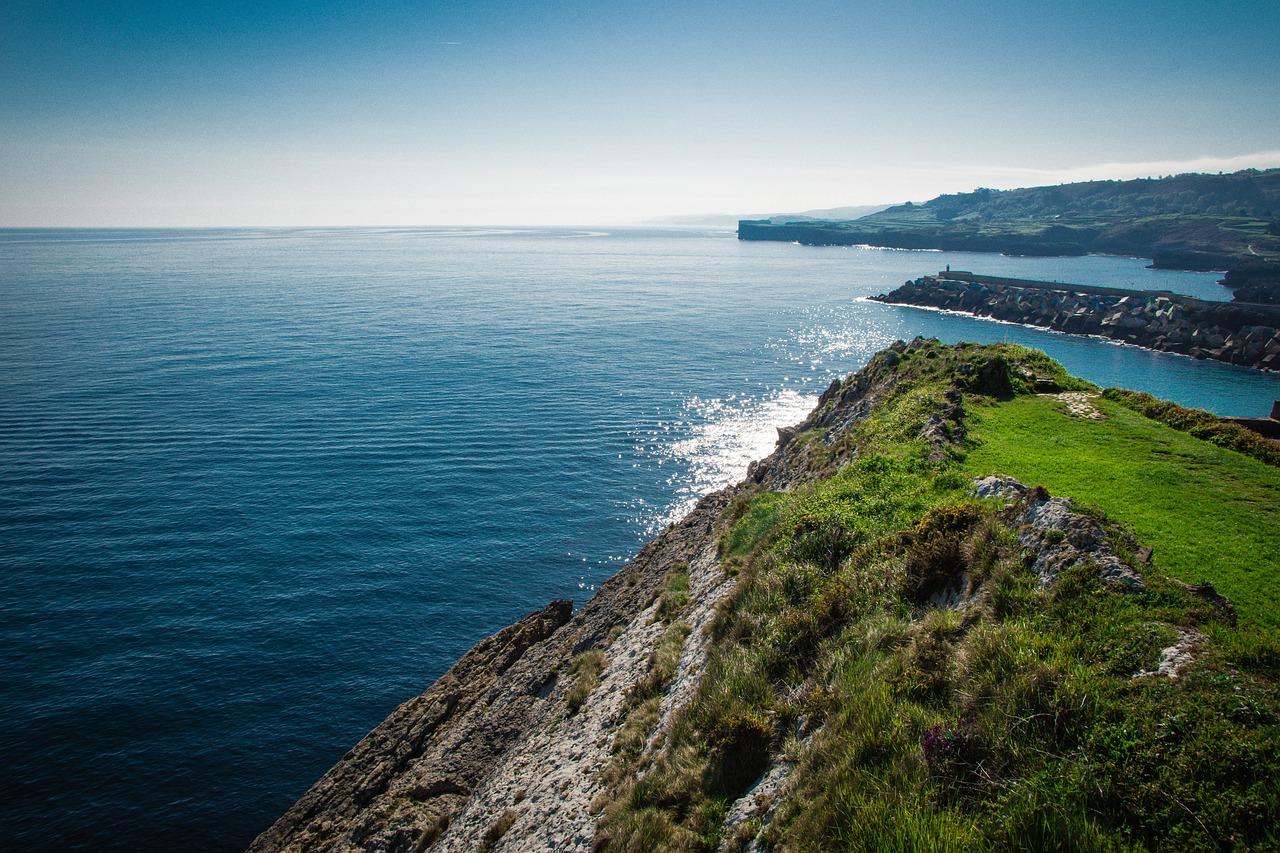Protected by natural wonders such as the Sierra del Cuera and the eastern coast of Asturias, Llanes is an emblematic municipality in northern Spain, widely known for its beauty, history, art, and the possibilities it offers. Thousands of people visit it each year for its beautiful beaches, its impressive natural surroundings, its well-preserved historical and monumental heritage, and the wide variety of activities and options available in its surroundings.
Thus, it’s no wonder that this town is the favorite choice for so many visitors each year. If you’re interested in learning more or planning to travel to Llanes soon… In this post, we’ll tell you everything you need to know to enjoy Llanes on your next visit!
What to See in Llanes
Llanes is like that friend who always has a great story to tell. Between postcard-perfect beaches and streets with centuries-old histories, this place is the perfect combination of fun and culture. Pack your backpack for adventures, lots of enthusiasm, and your camera. In Llanes, every corner promises to be your new favorite photo! Follow the route with us and discover the must-see sights in the Llanes area!
- Historic Center
The Historic Center of Llanes is of medieval heritage and, in addition to great beauty, it holds surprises such as the verses from Celso Amieva’s book, “Poems of Llanes”, written on the ground of the town.
Stroll through a town wrapped in history, color, and poetry, walk its streets and contemplate the medieval remnants that shape it, from its ancient gates of entry to the wall that once guarded the place, with one of the most impressive stretches of wall in northern Spain.
During your walk through the Historic Center, you can’t miss some emblematic locations such as the Basilica of Llanes, Gothic in style but with Romanesque elements (as its construction began in the 13th century).
The Tower, the house of Juan Pariente (the oldest house in Llanes), the Posada Herrera palace, the Palace of Gastañaga or that of the Duke of Estrada, are worth a visit. As well as the Cercáu house, the square and chapel of La Magdalena, or the square and chapel of Santa Ana.
- Port of Llanes: The Cubes of Memory
The port of Llanes, located where the sea meets the Carrocéu river, near the impressive San Pedro promenade and with incredible panoramic views of Cuera, hides an unusual secret in its breakwater: the materialization of the artistic work “The Cubes of Memory” by Agustín Ibarrola: more than 200 decorated concrete blocks.
This incredible outdoor artwork was implemented at the end of the 20th century and, since then, the port of Llanes has become, even more, one of the most unique and special ports in the world.
- San Pedro Promenade
Dating back to the 19th century, it is one of the most beautiful places to see in Llanes. From the San Pedro viewpoint, which offers spectacular views of Sablón Beach and the Historic Center of Llanes (including the wall), you can walk around the incredible cliffs where the Asturian coast meets the Cantabrian Sea. Walk through an impressive natural environment, take amazing photographs… And much more!
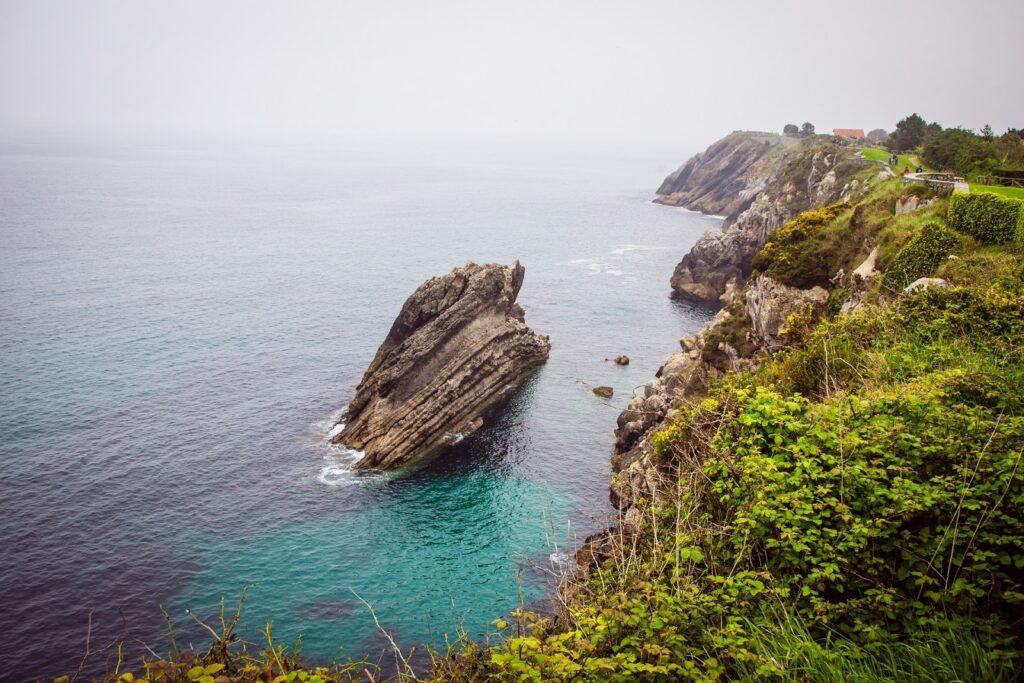
- Church of Santa María del Conceyu
It is one of the best buildings to see in Llanes, a church built between the 12th and 15th centuries that is one of the best-preserved examples of Gothic architecture in Asturias. It also has two Romanesque portals, a large bell tower, and a 16th-century rear door. Without a doubt, it’s a complete lesson in art and history that cannot be overlooked when visiting Llanes.
- Indianos Houses
The Indiano architecture was initiated by locals who returned from America after having gone to seek (and find) fortune. These large and elegant colonial-style mansion houses are typical structures of the region and a must-see when visiting Llanes.
One of the best examples in Llanes is Villa Parres, as it was the main location of the successful Spanish film “The Orphanage”. Although on both sides of Avenida de la Concepción, where it is located, you can find many other examples of Indiano architecture.
- Beaches of El Sablón, Puertu Chicu, and Toró
The three beaches are part of the town and are key points of its social life.
El Sablón is located near the port and at the foot of the San Pedro promenade, in the heart of Llanes. From its fine white sand, it’s possible to observe the wall and the path up to the promenade. Additionally, it’s a calm beach that, with the sea at peace, becomes a sort of natural swimming pool where both locals and tourists can enjoy the atmosphere and social activity.
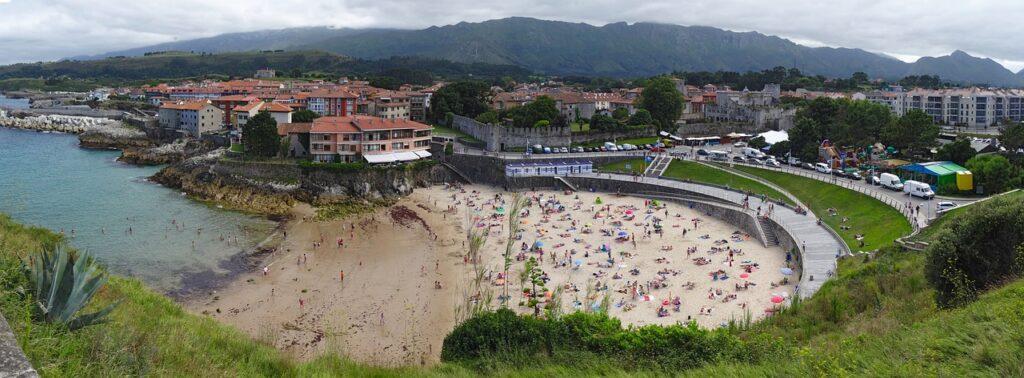
Toró is not just a beach, but a visual and scenic spectacle that integrates pointed rocks and natural formations in an idyllic natural setting. It has all the necessary amenities to enjoy a beach day, including a path for walking and enjoying the views.
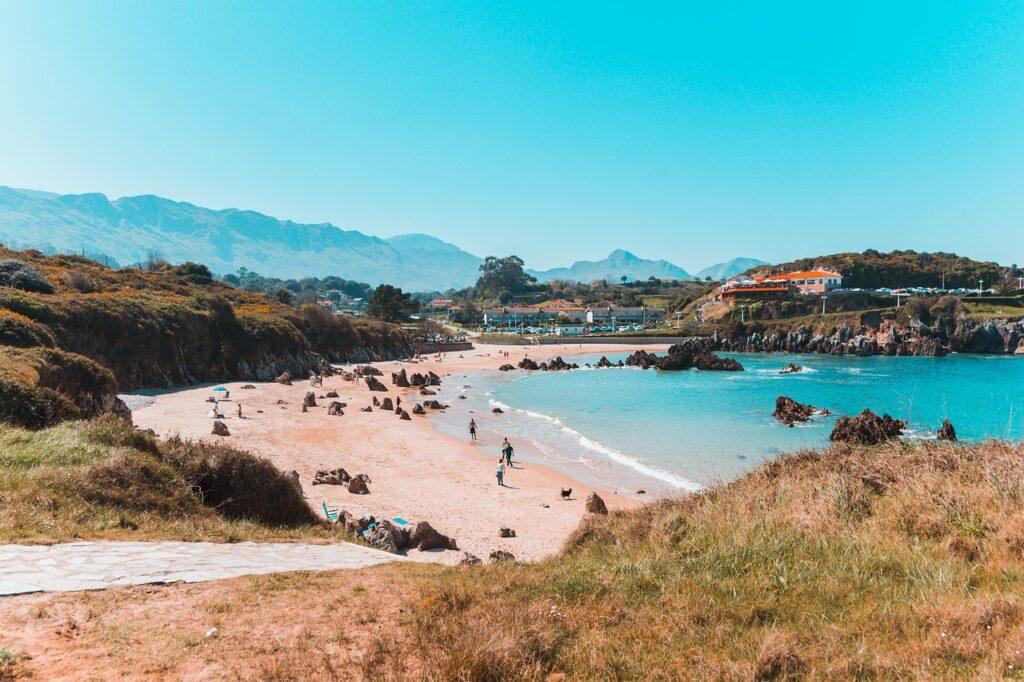
The Puertu Chicu beach is a smaller and more intimate cove. With a length of only 150 meters, this small haven of peace is located at the end of the San Antón promenade. You’ll love enjoying its white sand and its strange horseshoe shape! Keep in mind that Puerto Chicu practically disappears at high tide, so plan your visit carefully.
- Llanes Lighthouse
It is one of the best places to see in Llanes in one day. Walking up San Antón Street, you can take a pleasant stroll with beautiful views of the port and the town. You’ll pass by the Monument to the Fisherman’s Wife before reaching the Lighthouse, from where you can enjoy a privileged view of the Puertu Chicu beach.
What to See in Llanes and Surroundings
Visiting Llanes and its surroundings is like opening a book full of surprises. Here, where the sea and mountains meet, every corner has something special to offer. From quiet beaches to charming little villages, this area of northern Spain is perfect for those looking to escape the routine and enjoy nature and good food.
In this section, we mention what to see near Llanes and some fun activities to do. Get ready to discover with us the best of Llanes and its surroundings, where you’re sure to find something you’ll love.
- Gulpiyuri Beach: this small beach is a natural wonder hidden among fields. Although it’s away from the open sea, waves arrive through a system of underground caves, creating an oasis of saltwater. It’s like a little piece of sea surrounded by land, something you definitely don’t see every day and one of the landscapes to see around Llanes!
- Poo Beach and Poo de Llanes: Poo Beach is known for its peculiar shape and calm waters, thanks to its sheltered position. It’s ideal for families or those looking for a relaxing swim without the strong waves of the open sea. Poo de Llanes, the nearby village, is charming and offers a good selection of places to eat and enjoy the views.
- Bufones de Pría: These are spectacular geological formations where the sea, forcefully hitting the cliffs, expels water through openings in the rock, creating impressive natural geysers. The sound and views are stunning, especially during high tide or after a storm. This is one of the must-visit places near Llanes that you can’t miss.
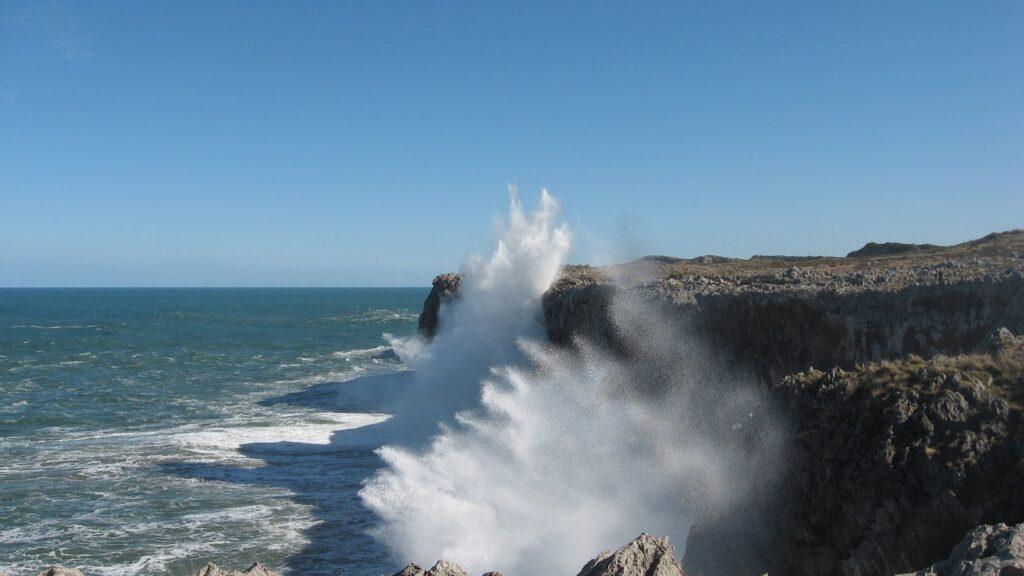
- Torimbia Beach: Considered by many as one of the most beautiful beaches in Asturias, Torimbia is a natural spectacle with its wide strip of white sand and crystal-clear waters.
- Cabrales: This small municipality is famous for its Cabrales cheese, a strong and delicious blue cheese, aged in natural caves in the region. Not only can you taste this famous cheese and the legendary Cabrales sauce, but you can also visit some of the caves where it’s aged and learn about its production process.
- Ribadesella: In addition to its natural beauty and architecture, Ribadesella offers the opportunity to experience a unique adventure: jet ski rides on the Cantabrian Sea. It’s an exciting way to see the coast from a different perspective and feel the adrenaline. Ribadesella is one of the towns to see near Llanes that can’t be missed on your trip to Asturias.
- Cangas de Onís: This charming town is known for its iconic Roman bridge and is an excellent starting point for exploring the Picos de Europa (for example, by buggy). The mix of history, culture, and nature makes it an unmissable destination.
- Covadonga Sanctuary and Lakes: A place of pilgrimage and natural beauty, the Covadonga Sanctuary and the nearby Lakes of Enol and Ercina are must-stop locations. The combination of alpine landscape with the history and spirituality of the place is simply magical.
- Colombres: Recognized for its ‘indianos’ architecture, Colombres offers an interesting glimpse into the architectural wealth brought by those who emigrated to America and returned.
- Lastres: This picturesque fishing village, with its steep streets and sea views, looks like it’s straight out of a postcard. It’s ideal for leisurely strolls, enjoying the views, and tasting fresh seafood in one of its restaurants.
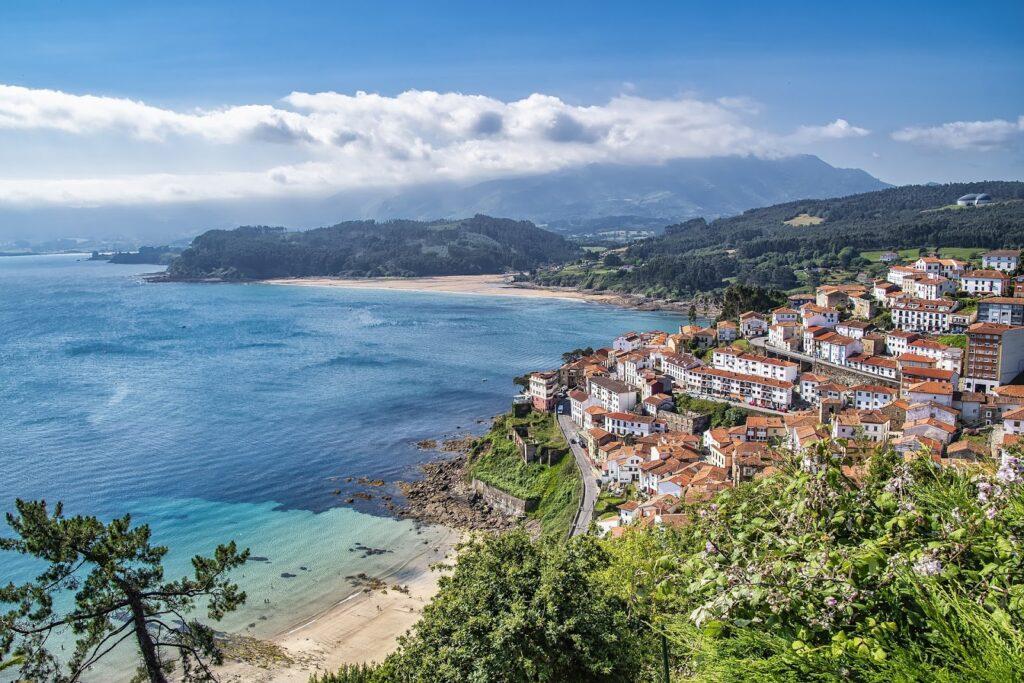
- Arriondas: For the adventurous, Arriondas is the starting point of the famous Sella River Descent, a unique canoeing experience down the Sella River. Rent a canoe and enjoy the river at your own pace.
The Gastronomy of Llanes
The gastronomy of Llanes, as a good representative of Asturias, is rich in flavors and traditions from both maritime and mountainous environments. The products of the sea and land combine in dishes that are a true delight for any palate. Here, cheese, cider, and seafood are the protagonists of a cuisine that celebrates the quality and freshness of its local ingredients.
One of the most emblematic elements of Llanes cuisine is undoubtedly the seafood, which is caught in the waters of the Cantabrian Sea and served fresh in many restaurants in the area. The Asturian fabada, with its combination of fabes (white beans), chorizo, blood sausage, and bacon, also has its place on the table in Llanes.
We can’t talk about local gastronomy without mentioning the famous Cabrales cheese, an intense blue cheese that is aged in natural caves. This cheese pairs perfectly with Asturian cider, another jewel of the region. Cider, a fermented apple juice beverage, is served in a traditional ‘pouring’ style and is perfect to accompany any meal.
We can’t forget to mention the cachopo, an iconic dish of Asturian gastronomy that is also very popular in Llanes. The cachopo consists of two large veal fillets, between which Serrano ham and cheese are placed, all of this breaded and fried until achieving a crispy and golden exterior. This delicious dish is typically served accompanied by French fries, roasted red peppers, or a salad.
Desserts are also an important pillar of Llanes’ gastronomy, highlighting the frixuelos, a type of thin crepe, and the rice pudding, which is prepared following traditional recipes.
Ready to visit Llanes? At Cangas Aventura, we encourage you to do so! We guarantee that you won’t regret it and that you’ll surely want to make a second visit to the town.

